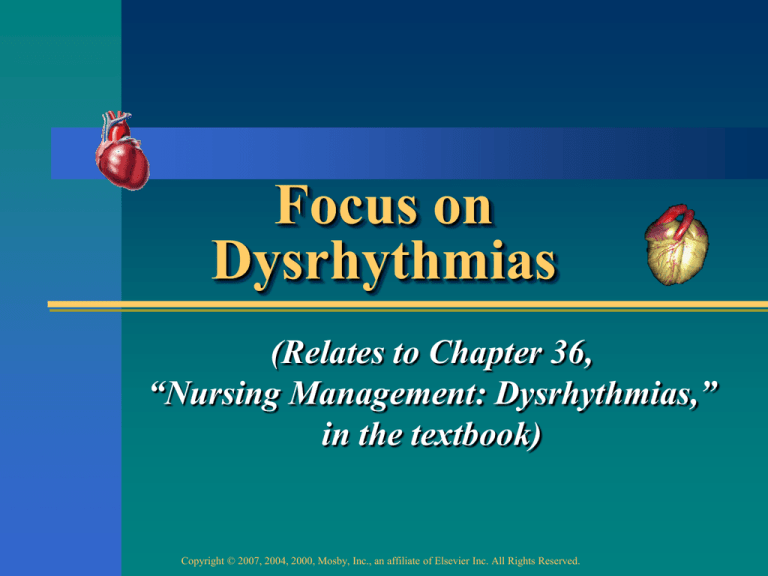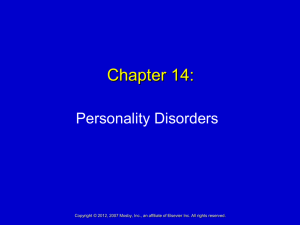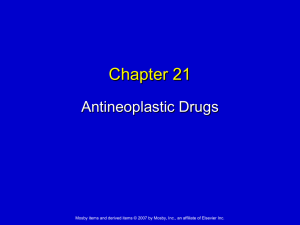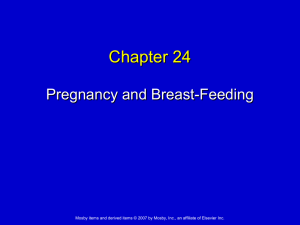
Focus on
Dysrhythmias
(Relates to Chapter 36,
“Nursing Management: Dysrhythmias,”
in the textbook)
Copyright © 2007, 2004, 2000, Mosby, Inc., an affiliate of Elsevier Inc. All Rights Reserved.
Dysrhythmias
Abnormal
cardiac rhythms are
termed dysrhythmias
May cause disturbances in rate,
rhythm or both
Copyright © 2007, 2004, 2000, Mosby, Inc., an affiliate of Elsevier Inc. All Rights Reserved.
Normal Electrical Conduction
The impulse that stimulates and paces the cardiac
muscle normally originates in the sinoatrial (SA)
node of the heart, located in the right atrium
Impulse travels quickly from the SA node, down to
the atrioventricular (AV node) - this causes atrial
contraction (“atrial kick)
Impulse then travels quickly through the bundle of
His, to the right and left bundle branches and the
Purkinje fibers, located in the ventricles - this causes
ventricular contraction
Copyright © 2007, 2004, 2000, Mosby, Inc., an affiliate of Elsevier Inc. All Rights Reserved.
Cardiac Conduction
QuickTime™ and a
decompressor
are needed to see this picture.
Fig. 36-1
Copyright © 2007, 2004, 2000, Mosby, Inc., an affiliate of Elsevier Inc. All Rights Reserved.
Nervous System Control of
the Heart
Autonomic
nervous system
controls:
Rate of impulse formation
Speed of conduction
Strength of contraction
Copyright © 2007, 2004, 2000, Mosby, Inc., an affiliate of Elsevier Inc. All Rights Reserved.
12-Lead ECG
12
recording leads
Six leads measure electrical forces
in the frontal plane (leads I, II, III,
aVR, aVL, and aVF)
Six leads (V1–V6) measure the
electrical forces in the horizontal
plane (precordial leads)
Copyright © 2007, 2004, 2000, Mosby, Inc., an affiliate of Elsevier Inc. All Rights Reserved.
Lead Placement
Fig. 36-2
Copyright © 2007, 2004, 2000, Mosby, Inc., an affiliate of Elsevier Inc. All Rights Reserved.
12-Lead ECG
Fig. 36-3
Copyright © 2007, 2004, 2000, Mosby, Inc., an affiliate of Elsevier Inc. All Rights Reserved.
Assessment of Cardiac Rhythm
Fig. 36-9
Copyright © 2007, 2004, 2000, Mosby, Inc., an affiliate of Elsevier Inc. All Rights Reserved.
Assessment of Cardiac Rhythm
Fig. 36-6
Copyright © 2007, 2004, 2000, Mosby, Inc., an affiliate of Elsevier Inc. All Rights Reserved.
Interpreting ECGs
Determining heart rate
1 minute strip contains 300 large boxes, 1500 small
boxes
1. 1500/# small boxes between R waves
2. 300 / #large boxes between R waves
3. A less accurate way: count the # of R waves
The heart’s normal pacemaker is the SA node (rate 60100
If the SA node fails, the AV node kicks in (rate 40-60
If the AV node fails, the ventricles take over (rate 2040)
Copyright © 2007, 2004, 2000, Mosby, Inc., an affiliate of Elsevier Inc. All Rights Reserved.
Interpreting ECGs
P wave
Represents depolarization of the atria
QRS complex
Represents ventricular depolarization
Q is the first negative deflection after the P wave
R is the first positive deflection after the P wave
S is the negative deflection after the R wave
<.12 sec in duration
Copyright © 2007, 2004, 2000, Mosby, Inc., an affiliate of Elsevier Inc. All Rights Reserved.
Interpreting ECGs
T wave
Ventricular repolarization
Same direction as QRS
U
wave
?repolarization of Purkinje fibers
Not usually present
May be seen in hypokalemia, HTN, heart
disease
Copyright © 2007, 2004, 2000, Mosby, Inc., an affiliate of Elsevier Inc. All Rights Reserved.
Analysis of Rhythm Strips
1. Determine the ventricular rate
2. Determine the rhythm
Is the R-R interval regular?
3. Identify P waves
Is there a P for every QRS?
Is it upright?
4. Determine the PR interval duration
Is it consistent?
5. Determine the QRS duration
Copyright © 2007, 2004, 2000, Mosby, Inc., an affiliate of Elsevier Inc. All Rights Reserved.
Normal Sinus Rhythm
Sinus
node fires 60 to 100 bpm
Follows normal conduction
pattern
Fig. 36-8
Copyright © 2007, 2004, 2000, Mosby, Inc., an affiliate of Elsevier Inc. All Rights Reserved.
Evaluation of Dysrhythmias
Holter monitoring
Event
recorder monitoring
Exercise treadmill testing
Signal-averaged ECG
Electrophysiologic study
Copyright © 2007, 2004, 2000, Mosby, Inc., an affiliate of Elsevier Inc. All Rights Reserved.
Sinus Bradycardia
Sinus node fires <60 bpm
Normal rhythm is aerobically trained
athletes and during sleep
Fig. 36-11 A
Copyright © 2007, 2004, 2000, Mosby, Inc., an affiliate of Elsevier Inc. All Rights Reserved.
Sinus Bradycardia
Clinical
associations
Occurs in response to
Carotid sinus massage
Hypothermia
Increased vagal tone
Administration of
parasympathomimetic drugs
Copyright © 2007, 2004, 2000, Mosby, Inc., an affiliate of Elsevier Inc. All Rights Reserved.
Sinus Bradycardia
Clinical
associations
Occurs in disease states
Hypothyroidism
Increased intracranial pressure
Inferior wall MI
Copyright © 2007, 2004, 2000, Mosby, Inc., an affiliate of Elsevier Inc. All Rights Reserved.
Sinus Bradycardia
Clinical significance
Dependent on symptoms
Hypotension
Pale, cool skin
Weakness
Angina
Dizziness or syncope
Confusion or disorientation
Shortness of breath
Copyright © 2007, 2004, 2000, Mosby, Inc., an affiliate of Elsevier Inc. All Rights Reserved.
Sinus Bradycardia
Treatment
Atropine
Pacemaker may be required
Copyright © 2007, 2004, 2000, Mosby, Inc., an affiliate of Elsevier Inc. All Rights Reserved.
Sinus Tachycardia
Discharge rate from the sinus node is
increased as a result of vagal inhibition
and is >100 bpm
Fig. 35-11 B
Copyright © 2007, 2004, 2000, Mosby, Inc., an affiliate of Elsevier Inc. All Rights Reserved.
Sinus Tachycardia
Clinical
associations
Associated with physiologic stressors
Exercise
Pain
Hypovolemia
Myocardial ischemia
Heart failure (HF)
Fever
Copyright © 2007, 2004, 2000, Mosby, Inc., an affiliate of Elsevier Inc. All Rights Reserved.
Sinus Tachycardia
Clinical
significance
Dizziness and hypotension due
to decreased CO
Increased myocardial oxygen
consumption may lead to angina
Copyright © 2007, 2004, 2000, Mosby, Inc., an affiliate of Elsevier Inc. All Rights Reserved.
Sinus Tachycardia
Treatment
Determined by underlying cause
-Adrenergic blockers to reduce
HR and myocardial oxygen
consumption
Antipyretics to treat fever
Analgesics to treat pain
Copyright © 2007, 2004, 2000, Mosby, Inc., an affiliate of Elsevier Inc. All Rights Reserved.
Premature Atrial Contraction
Contraction
originating from
ectopic focus in atrium in
location other than SA node
Travels across atria by abnormal
pathway, creating distorted P
wave
May be stopped, delayed, or
conducted normally at the AV
node
Copyright © 2007, 2004, 2000, Mosby, Inc., an affiliate of Elsevier Inc. All Rights Reserved.
Premature Atrial Contraction
Fig. 36-12
Copyright © 2007, 2004, 2000, Mosby, Inc., an affiliate of Elsevier Inc. All Rights Reserved.
Premature Atrial Contraction
Clinical
associations
Can result from
Emotional stress
Use of caffeine, tobacco, alcohol
Hypoxia
Electrolyte imbalances
COPD
Valvular disease
Copyright © 2007, 2004, 2000, Mosby, Inc., an affiliate of Elsevier Inc. All Rights Reserved.
Premature Atrial Contraction
Clinical
significance
Isolated PACs are not significant in
those with healthy hearts
In persons with heart disease, may
be warning of more serious
dysrhythmia
Copyright © 2007, 2004, 2000, Mosby, Inc., an affiliate of Elsevier Inc. All Rights Reserved.
Premature Atrial Contraction
Treatment
Depends on symptoms
-Adrenergic blockers may be
used to decrease PACs
Reduce or eliminate caffeine
Copyright © 2007, 2004, 2000, Mosby, Inc., an affiliate of Elsevier Inc. All Rights Reserved.
Paroxysmal Supraventricular
Tachycardia (PSVT)
Originates
in ectopic focus
anywhere above bifurcation of
bundle of His
Run of repeated premature beats
is initiated and is usually a PAC
Paroxysmal refers to an abrupt
onset and termination
Copyright © 2007, 2004, 2000, Mosby, Inc., an affiliate of Elsevier Inc. All Rights Reserved.
Paroxysmal Supraventricular
Tachycardia (PSVT)
Fig. 36-13
Copyright © 2007, 2004, 2000, Mosby, Inc., an affiliate of Elsevier Inc. All Rights Reserved.
Paroxysmal Supraventricular
Tachycardia (PSVT)
Clinical
associations
In a normal heart
Overexertion
Emotional stress
Stimulants
Digitalis toxicity
Rheumatic heart disease
CAD
Cor pulmonale
Copyright © 2007, 2004, 2000, Mosby, Inc., an affiliate of Elsevier Inc. All Rights Reserved.
Paroxysmal Supraventricular
Tachycardia (PSVT)
Clinical
significance
Prolonged episode and HR >180
bpm may precipitate ↓ CO
Palpitations
Hypotension
Dyspnea
Angina
Copyright © 2007, 2004, 2000, Mosby, Inc., an affiliate of Elsevier Inc. All Rights Reserved.
Paroxysmal Supraventricular
Tachycardia (PSVT)
Treatment
Vagal maneuvers: Valsalva, coughing
IV adenosine
If vagal maneuvers and/or drug
therapy is ineffective and/or patient
becomes hemodynamically unstable,
DC cardioversion should be used
Copyright © 2007, 2004, 2000, Mosby, Inc., an affiliate of Elsevier Inc. All Rights Reserved.
Atrial Flutter
Atrial
tachydysrhythmia
identified by recurring, regular,
sawtooth-shaped flutter waves
Originates from a single ectopic
focus
Copyright © 2007, 2004, 2000, Mosby, Inc., an affiliate of Elsevier Inc. All Rights Reserved.
Atrial Flutter
Fig. 36-14A
Copyright © 2007, 2004, 2000, Mosby, Inc., an affiliate of Elsevier Inc. All Rights Reserved.
Atrial Flutter
Clinical
associations
Usually occurs with
CAD
Hypertension
Mitral valve disorders
Pulmonary embolus
Chronic lung disease
Cardiomyopathy
Hyperthyroidism
Drugs: Digoxin, quinidine, epinephrine
Copyright © 2007, 2004, 2000, Mosby, Inc., an affiliate of Elsevier Inc. All Rights Reserved.
Atrial Flutter
Clinical
significance
High ventricular rates (>100) and
loss of the atrial “kick” can decrease
CO and precipitate HF, angina
Risk for stroke due to risk of
thrombus formation in the atria
Copyright © 2007, 2004, 2000, Mosby, Inc., an affiliate of Elsevier Inc. All Rights Reserved.
Atrial Flutter
Treatment
Primary goal is to slow ventricular
response by increasing AV block
Drugs to slow HR: Calcium channel
blockers, -adrenergic blockers
Electrical cardioversion may be used
to convert the atrial flutter to sinus
rhythm emergently and electively
Copyright © 2007, 2004, 2000, Mosby, Inc., an affiliate of Elsevier Inc. All Rights Reserved.
Atrial Flutter
Treatment
Primary goal is to slow ventricular
response by increasing AV block
Antidysrhythmia drugs to convert
atrial flutter to sinus rhythm or to
maintain sinus rhythm (e.g.,
amiodarone, propafenone)
Radiofrequency catheter ablation can
be curative therapy for atrial flutter
Copyright © 2007, 2004, 2000, Mosby, Inc., an affiliate of Elsevier Inc. All Rights Reserved.
Atrial Fibrillation
Total
disorganization of atrial
electrical activity due to multiple
ectopic foci resulting in loss of
effective atrial contraction
Most common dysrhythmia
Prevalence increases with age
Copyright © 2007, 2004, 2000, Mosby, Inc., an affiliate of Elsevier Inc. All Rights Reserved.
QuickTime™ and a
YUV420 codec decompressor
are needed to see this picture.
Copyright © 2007, 2004, 2000, Mosby, Inc., an affiliate of Elsevier Inc. All Rights Reserved.
Atrial Fibrillation
Fig. 36-14B
Copyright © 2007, 2004, 2000, Mosby, Inc., an affiliate of Elsevier Inc. All Rights Reserved.
Atrial Fibrillation
Clinical
associations
Usually occurs with
Underlying heart disease, such as
rheumatic heart disease, CAD
Cardiomyopathy
HF
Pericarditis
Copyright © 2007, 2004, 2000, Mosby, Inc., an affiliate of Elsevier Inc. All Rights Reserved.
Atrial Fibrillation
Clinical
associations
Often acutely caused by
Thyrotoxicosis
Alcohol intoxication
Caffeine use
Electrolyte disturbance
Cardiac surgery
Copyright © 2007, 2004, 2000, Mosby, Inc., an affiliate of Elsevier Inc. All Rights Reserved.
Atrial Fibrillation
Clinical
significance
Can result in decrease in CO due to
ineffective atrial contractions (loss
of atrial kick) and rapid ventricular
response
Thrombi may form in the atria as a
result of blood stasis
Embolus may develop and travel to
the brain, causing a stroke
Copyright © 2007, 2004, 2000, Mosby, Inc., an affiliate of Elsevier Inc. All Rights Reserved.
Atrial Fibrillation
Treatment
Goals
Decrease ventricular response
Prevent embolic stroke
Drugs for rate control: digoxin, adrenergic blockers, calcium
channel blockers
Long-tern anticoagulation:
Coumadin
Copyright © 2007, 2004, 2000, Mosby, Inc., an affiliate of Elsevier Inc. All Rights Reserved.
Atrial Fibrillation
Treatment
For some patients, conversion to
sinus rhythm may be considered
Antidysrhythmic drugs used for
conversion: Amiodarone,
propafenone
DC cardioversion may be used to
convert atrial fibrillation to
normal sinus rhythm
Copyright © 2007, 2004, 2000, Mosby, Inc., an affiliate of Elsevier Inc. All Rights Reserved.
Atrial Fibrillation
Treatment
If patient has been in atrial
fibrillation for >48 hours,
anticoagulation therapy with
warfarin is recommended for
3 to 4 weeks before cardioversion
and for 4 to 6 weeks after
successful cardioversion
Copyright © 2007, 2004, 2000, Mosby, Inc., an affiliate of Elsevier Inc. All Rights Reserved.
Atrial Fibrillation
Treatment
Radiofrequency catheter ablation
Maze surgical procedure
Modifications to the Maze
procedure
Use of cold (cryoablation)
Use of heat (high-intensity
ultrasound)
Copyright © 2007, 2004, 2000, Mosby, Inc., an affiliate of Elsevier Inc. All Rights Reserved.
Junctional Dysrhythmias
Dysrhythmia
that originates in
area of AV node
SA node has failed to fire or
impulse has been blocked at the
AV node
Copyright © 2007, 2004, 2000, Mosby, Inc., an affiliate of Elsevier Inc. All Rights Reserved.
Junctional Dysrhythmias
Fig. 36-15
Copyright © 2007, 2004, 2000, Mosby, Inc., an affiliate of Elsevier Inc. All Rights Reserved.
Junctional Dysrhythmias
Treatment
If symptomatic, atropine
-Adrenergic blockers, calcium
channel blockers, and amiodarone
used for rate control for junctional
tachycardia not caused by digoxin
toxicity
DC cardioversion is
contraindicated
Copyright © 2007, 2004, 2000, Mosby, Inc., an affiliate of Elsevier Inc. All Rights Reserved.
Heart Block
Copyright © 2007, 2004, 2000, Mosby, Inc., an affiliate of Elsevier Inc. All Rights Reserved.
Premature Ventricular
Contractions
Contraction
originating in
ectopic focus of the ventricles
Premature occurrence of a wide
and distorted QRS complex
Multifocal, unifocal, ventricular
bigeminy, ventricular trigeminy,
couples, triplets, R on T
phenomena
Copyright © 2007, 2004, 2000, Mosby, Inc., an affiliate of Elsevier Inc. All Rights Reserved.
Premature Ventricular
Contractions
Fig. 36-17
Copyright © 2007, 2004, 2000, Mosby, Inc., an affiliate of Elsevier Inc. All Rights Reserved.
Premature Ventricular
Contractions
Clinical associations
Stimulants: Caffeine, alcohol, nicotine,
aminophylline, epinephrine, isoproterenol
Digoxin
Electrolyte imbalances
Hypoxia
Fever
Disease states: MI, mitral valve prolapse,
HF, CAD
Copyright © 2007, 2004, 2000, Mosby, Inc., an affiliate of Elsevier Inc. All Rights Reserved.
Premature Ventricular
Contractions
Clinical significance
In normal heart, usually benign
In heart disease, PVCs may decrease CO
and precipitate angina and HF
Patient’s response to PVCs must be
monitored
PVCs often do not generate a sufficient
ventricular contraction to result in a
peripheral pulse
Apical-radial pulse rate should be
assessed to determine if pulse deficit
exists
Copyright © 2007, 2004, 2000, Mosby, Inc., an affiliate of Elsevier Inc. All Rights Reserved.
Premature Ventricular
Contractions
Clinical
significance
Represents ventricular irritability
Copyright © 2007, 2004, 2000, Mosby, Inc., an affiliate of Elsevier Inc. All Rights Reserved.
Premature Ventricular
Contractions
Treatment
Based on cause of PVCs
Oxygen therapy for hypoxia
Electrolyte replacement
Drugs: -Adrenergic blockers,
procainamide, amiodarone,
lidocaine
Copyright © 2007, 2004, 2000, Mosby, Inc., an affiliate of Elsevier Inc. All Rights Reserved.
Ventricular Tachycardia
Run
of three or more PVCs
sustained and nonsustained
Considered life-threatening
because of decreased CO and the
possibility of deterioration
ventricular fibrillation
Copyright © 2007, 2004, 2000, Mosby, Inc., an affiliate of Elsevier Inc. All Rights Reserved.
Ventricular Tachycardia
Fig. 36-18A
Copyright © 2007, 2004, 2000, Mosby, Inc., an affiliate of Elsevier Inc. All Rights Reserved.
Ventricular Tachycardia
Fig. 36-18B
Copyright © 2007, 2004, 2000, Mosby, Inc., an affiliate of Elsevier Inc. All Rights Reserved.
Ventricular Tachycardia
Clinical
associations
MI
CAD
Electrolyte imbalances
Cardiomyopathy
Mitral valve prolapse
Long QT syndrome
Digitalis toxicity
Central nervous system disorders
Copyright © 2007, 2004, 2000, Mosby, Inc., an affiliate of Elsevier Inc. All Rights Reserved.
Ventricular Tachycardia
Clinical
significance
VT can be stable (patient has a pulse)
or unstable (patient is pulseless)
Sustained VT: Severe decrease
in CO
–Hypotension
–Pulmonary edema
–Decreased cerebral blood flow
–Cardiopulmonary arrest
Copyright © 2007, 2004, 2000, Mosby, Inc., an affiliate of Elsevier Inc. All Rights Reserved.
Ventricular Tachycardia
Clinical
significance
Treatment for VT must be rapid
May recur if prophylactic
treatment is not initiated
Ventricular fibrillation may
develop
Copyright © 2007, 2004, 2000, Mosby, Inc., an affiliate of Elsevier Inc. All Rights Reserved.
Ventricular Tachycardia
Treatment
Precipitating causes must be identified
and treated (e.g., hypoxia)
With a pulse
Chemical cardioversion with
amiodarone, lidocaine
Electrical cardoversion
Copyright © 2007, 2004, 2000, Mosby, Inc., an affiliate of Elsevier Inc. All Rights Reserved.
Ventricular Tachycardia
Treatment
VT without a pulse is a lifethreatening situation
Cardiopulmonary
resuscitation (CPR) and rapid
defibrillation
–Epinephrine if defibrillation
is unsuccessful
Copyright © 2007, 2004, 2000, Mosby, Inc., an affiliate of Elsevier Inc. All Rights Reserved.
Ventricular Fibrillation
Severe
derangement of the
heart rhythm characterized on
ECG by irregular undulations
of varying contour and
amplitude
No effective contraction or CO
occurs
Copyright © 2007, 2004, 2000, Mosby, Inc., an affiliate of Elsevier Inc. All Rights Reserved.
Ventricular Fibrillation
Fig. 36-19
Copyright © 2007, 2004, 2000, Mosby, Inc., an affiliate of Elsevier Inc. All Rights Reserved.
Ventricular Fibrillation
Clinical associations
Acute MI, CAD, cardiomyopathy
VF may occur during cardiac pacing
or cardiac catheterization
VF may occur with coronary
reperfusion after fibrinolytic therapy
Accidental electrical shock
Hyperkalemia
Hypoxia
Acidosis
Drug toxicity
Copyright © 2007, 2004, 2000, Mosby, Inc., an affiliate of Elsevier Inc. All Rights Reserved.
Ventricular Fibrillation
Clinical
significance
Unresponsive, pulseless, and
apneic state
If not treated rapidly, death
will result
Copyright © 2007, 2004, 2000, Mosby, Inc., an affiliate of Elsevier Inc. All Rights Reserved.
Ventricular Fibrillation
Treatment
Immediate initiation of CPR
and advanced cardiac life
support (ACLS) measures with
the use of defibrillation and
definitive drug therapy
Copyright © 2007, 2004, 2000, Mosby, Inc., an affiliate of Elsevier Inc. All Rights Reserved.
Asystole
Represents
total absence of
ventricular electrical activity
No ventricular contraction
(CO) occurs because
depolarization does not occur
Copyright © 2007, 2004, 2000, Mosby, Inc., an affiliate of Elsevier Inc. All Rights Reserved.
Asystole
Clinical
significance
Unresponsive, pulseless, and
apneic state
Prognosis for asystole is
extremely poor
Copyright © 2007, 2004, 2000, Mosby, Inc., an affiliate of Elsevier Inc. All Rights Reserved.
Asystole
Treatment
CPR with initiation of ACLS
measures (e.g., intubation,
transcutaneous pacing, and IV
therapy with epinephrine and
atropine)
Copyright © 2007, 2004, 2000, Mosby, Inc., an affiliate of Elsevier Inc. All Rights Reserved.
Prodysrhythmia State
Clinical
significance
Antidysrhythmic drugs may cause
life-threatening dysrhythmias
Risk increases in presence of
Severe LV dysfunction
Digoxin and class IA, IC, and III
antidysrhythmia drugs
Copyright © 2007, 2004, 2000, Mosby, Inc., an affiliate of Elsevier Inc. All Rights Reserved.
Defibrillation
Most
effective method of
terminating VF and pulseless
VT
Passage of DC electrical shock
through the heart to depolarize
the cells of the myocardium to
allow the SA node to resume the
role of pacemaker
Copyright © 2007, 2004, 2000, Mosby, Inc., an affiliate of Elsevier Inc. All Rights Reserved.
Defibrillation
Fig. 36-20 A and B
Copyright © 2007, 2004, 2000, Mosby, Inc., an affiliate of Elsevier Inc. All Rights Reserved.
Defibrillation
Output is measured in joules or
watts per second
Recommended energy for initial
shocks in defibrillation
Biphasic defibrillators: First and
successive shocks: 150 to 200 joules
Monophasic defibrillators: Initial
shock at 360 joules
After the initial shock, chest
compressions (CPR) should be
started
Copyright © 2007, 2004, 2000, Mosby, Inc., an affiliate of Elsevier Inc. All Rights Reserved.
Defibrillation
Fig. 36-21
Copyright © 2007, 2004, 2000, Mosby, Inc., an affiliate of Elsevier Inc. All Rights Reserved.
Synchronized Cardioversion
Choice of therapy for
hemodynamically unstable
ventricular or supraventricular
tachydysrhythmias
Synchronized circuit delivers a
countershock on the R wave of
the QRS complex of the ECG
*Synchronizer switch must be
turned *
Copyright © 2007, 2004, 2000, Mosby, Inc., an affiliate of Elsevier Inc. All Rights Reserved.
Implantable CardioverterDefibrillator (ICD)
Appropriate
for patients who
Have survived SCD
Have spontaneous sustained VT
Have syncope with inducible
ventricular tachycardia/fibrillation
during EPS
Are at high risk for future lifethreatening dysrhythmias
Copyright © 2007, 2004, 2000, Mosby, Inc., an affiliate of Elsevier Inc. All Rights Reserved.
Implantable CardioverterDefibrillator (ICD)
ICD
sensing system monitors the
HR and rhythm and identifies
VT or VF
Approximately 25 seconds after
detecting VT or VF, ICD delivers
shock
If first shock is unsuccessful, ICD
recycles and delivers successive
shocks
Copyright © 2007, 2004, 2000, Mosby, Inc., an affiliate of Elsevier Inc. All Rights Reserved.
Implantable CardioverterDefibrillator (ICD)
Fig. 36-22
Copyright © 2007, 2004, 2000, Mosby, Inc., an affiliate of Elsevier Inc. All Rights Reserved.
Implantable CardioverterDefibrillator (ICD)
Education is extremely important
Variety of emotions are possible
Fear of body image change
Fear of recurrent dysrhythmias
Expectation of pain with ICD
discharge
Anxiety about going home
Participation in an ICD support
group should be encouraged
Copyright © 2007, 2004, 2000, Mosby, Inc., an affiliate of Elsevier Inc. All Rights Reserved.
Pacemakers
Used to pace the heart when the normal
conduction pathway is damaged or diseased
Pacing circuit consists of a power source,
one or more conducting (pacing) leads,
and the myocardium
Electrical signal (stimulus) travels from
the pacemaker, through the leads, to the
wall of the myocardium
Myocardium is “captured” and stimulated
to contract
Copyright © 2007, 2004, 2000, Mosby, Inc., an affiliate of Elsevier Inc. All Rights Reserved.
Pacemakers
Fig. 36-23
Copyright © 2007, 2004, 2000, Mosby, Inc., an affiliate of Elsevier Inc. All Rights Reserved.
Pacemakers
Initially indicated for symptomatic
bradydysrhythmias
Copyright © 2007, 2004, 2000, Mosby, Inc., an affiliate of Elsevier Inc. All Rights Reserved.
Pacemakers
Temporary
pacemaker: Power
source outside the body
Transvenous
Epicardial
Transcutaneous
Copyright © 2007, 2004, 2000, Mosby, Inc., an affiliate of Elsevier Inc. All Rights Reserved.
Pacemakers
Fig. 36-25
Fig. 36-26
Copyright © 2007, 2004, 2000, Mosby, Inc., an affiliate of Elsevier Inc. All Rights Reserved.
Pacemakers
Fig. 36-27
Copyright © 2007, 2004, 2000, Mosby, Inc., an affiliate of Elsevier Inc. All Rights Reserved.
Pacemakers
Fig. 36-24 A
Fig. 36-24 B
Copyright © 2007, 2004, 2000, Mosby, Inc., an affiliate of Elsevier Inc. All Rights Reserved.
Pacemakers
Pacemaker malfunction
Failure to sense: Failure to recognize
spontaneous atrial or ventricular
activity and pacemaker fires
inappropriately
Lead damage, battery failure,
dislodgement of the electrode
Copyright © 2007, 2004, 2000, Mosby, Inc., an affiliate of Elsevier Inc. All Rights Reserved.
Pacemakers
Pacemaker malfunction
Failure to capture: Electrical charge
to myocardium is insufficient to
produce atrial or ventricular
contraction
Lead damage, battery failure,
dislodgement of the electrode,
fibrosis at the electrode tip
Patient education
Copyright © 2007, 2004, 2000, Mosby, Inc., an affiliate of Elsevier Inc. All Rights Reserved.
ECG Changes Associated with Acu
Coronary Syndrome (ACS)
Definitive ECG changes occur in
response to ischemia, injury, or
infarction of myocardial cells
Changes seen in the leads that face the
area of involvement
Reciprocal (opposite) ECG changes
often seen in the leads facing opposite
the area involved
Pattern of ECG changes will provide
information on the coronary artery
involved in ACS
Copyright © 2007, 2004, 2000, Mosby, Inc., an affiliate of Elsevier Inc. All Rights Reserved.
ECG Changes Associated with Acute
Coronary Syndrome (ACS)
Fig. 36-29 B
Copyright © 2007, 2004, 2000, Mosby, Inc., an affiliate of Elsevier Inc. All Rights Reserved.





